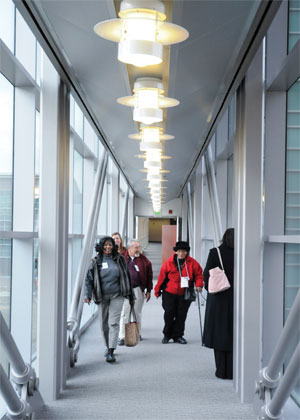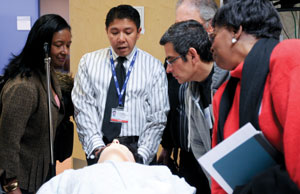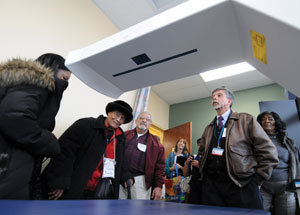Learning from Each Other
By Tonia Twichell
 (May 2012) The year was 1955 and incoming CU Boulder freshman Pat Vigil got his first impression of the campus and his place in it.
(May 2012) The year was 1955 and incoming CU Boulder freshman Pat Vigil got his first impression of the campus and his place in it.
“It was a culture shock. Out of 20,000 students there were about five who looked like me,” says Vigil, a long-time Denver community activist.
In the ensuing years, Vigil realized that “there was a feeling among Latinos in Denver that the University of Colorado was discriminatory toward us.”
But in 2010, Vigil had a chance to reassess. He became one of dozens of community leaders to guide School of Medicine and other University of Colorado researchers through medically underserved urban and rural communities as part of Colorado Immersion Training (CIT) in Community Engagement through the Colorado Clinical & Translational Sciences Institute.
The program began in 2010 with a National Institutes of Health grant modeled on a program in Pittsburgh, where doctors would enter the community for a few days, according to co-directors Jack Westfall, MD, and Linda Zittleman, MPH.
“We took that model and made it more in-depth and long-term,” says Westfall, associate dean of rural health and director of the High Plains Research Network and of Colorado Area Health Education Center (AHEC).
Designed to strengthen Anschutz Medical Campus ties with the community, the program puts researchers into churches, clinics, schools, rec centers and other sites with people who will help steer future research and discover ways to bring breakthroughs to the community.
“It takes about 17 years on average for new clinical discoveries to get into everyday practice,” Zittleman says. “In the meantime communities are suffering from health disparities.”
One reason they believe in community engagement comes from their expeience on the eastern plains, where they worked with community members to spread the word on colon cancer prevention through print materials and presentations at local civic clubs. Westfall recalls being at a health fair when a man said, “This project saved my life.”
He’d heard a local man give a talk at the Haxtun Gun Club about his colon screening, and he followed up by asking his own doctor about a colonoscopy. It showed he had precancerous polyps.
He told Westfall that without that talk “I wouldn’t have gone and gotten tested.”
 Researchers have to put in a month of upfront reading and study. Then for one week, partnered with a community guide, they immerse themselves. Of the 44 who have gone through since 2010, almost all said they felt emotionally connected to their new community, Westfall says.
Researchers have to put in a month of upfront reading and study. Then for one week, partnered with a community guide, they immerse themselves. Of the 44 who have gone through since 2010, almost all said they felt emotionally connected to their new community, Westfall says.
Each researcher is provided six months of support through the CCTSI and the local community liaisons, which helps translate ideas into action.
The openness of researchers impressed Vigil.
“You could feel the compassion,” says Vigil, who has guided two groups through the Latino community. “Later, all the people at the agencies we took the researchers to said ‘These are really good, really brilliant people.’ “These are the kind of things you’ll remember for the rest of your life.”
By Westfall’s measurement, the program has been “wildly successful”—for both community and researchers.
“Many community members have commented that they didn’t picture the researchers being so passionate. For some of the researchers, it changed the trajectory of their research forever.”
Count Westfall among them.
“It strengthened my commitment. I can’t imagine doing research again without engaging the community.”
CIT includes six community tracks. Two are in rural areas—eastern Colorado and San Luis Valley— and four are in the Denver area for African-Americans, American Indians, Latinos and the Asian and refugee population.
There is also an academic immersion program
in which community members are invited onto campus for one day to meet with researchers, visit labs and watch medical simulations.
When researcher Linda Overholser, MD, assistant professor in the Division of General Internal Medicine, heard about the immersion program, she was instantly on board.
Overholser came from a semi-rural area of Kansas and had already spent some time on the eastern plains working with community groups.
Her interest lies in helping rural primary care doctors keep current with care for cancer survivors. She’d already started two clinics: one for survivors of childhood cancer and another for adult survivors of breast cancer.
“But what I found was that there were several intervention programs directed to patients, but few to primary care doctors,” says Overholser, who is now co-director of the Colorado LIVESTRONG® Survivorship Center of Excellence Network Program.
 “At an academic medical center like this one you’d have your medical oncologist, a health oncologist and a nurse coordinator to work on your case. But how can you provide those services in the San Luis Valley to an adult survivor of childhood cancer?”
“At an academic medical center like this one you’d have your medical oncologist, a health oncologist and a nurse coordinator to work on your case. But how can you provide those services in the San Luis Valley to an adult survivor of childhood cancer?”
She has since applied for two new grants to help bring information to San Luis Valley doctors.
“You can’t forget the people outside of Denver,” she says.
Nia Mitchell, MD, MPH, assistant professor for internal medicine, started one grant in August and is waiting on word for the next two. She was already interested in obesity in the African-American community and through the immersion program she expanded to senior citizens.
“It was the perfect opportunity because I was interested in doing something with seniors,” says Mitchell, whose grant opened three weight-loss chapters, called Take Off Pounds Sensibly (TOPS), in the community.
These groups have charted an average of four pounds lost over 12 weeks.
“It might not sound like that much, but with that age group you expect weight gain, so actually staying stable is a victory.”
Mitchell, who signed up for the American Indian CIT track this spring, is planning to study the TOPS program in the American Indian population as well.
Community activist Owetta McNeil enjoyed showing researchers around her northeast Denver community so much that she is getting ready to host her third immersion.
“We have so much fun,” she says. She remembers one researcher who, at the end of the immersion week, stood up before the crowd of community members and said, “‘I want to be black.”
The Rev. Lee Hall of Grace Christian Center in Montbello took the opposite journey—into academic immersion in which he spent a day on campus.
“I think the take back for me was to know that there were people that always were out there working for the common good. They’re always trying to find new ways of helping people. I saw them as people who were not necessarily in it for themselves and who could save people a lot of pain—could save lives.”
For Vigil, the impact is a little more personal.
“I am elated at the changes that have come about since 1955,” he says. “Now I really value my relationship with the University of Colorado so much. It’s a major part of my life.”